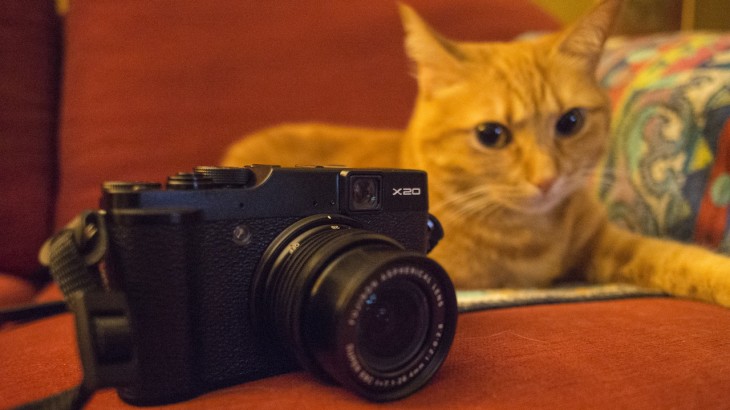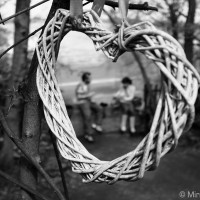The Fujifilm X20 and X100s are two X-series cameras that were released with great anticipation in the March/April of 2013. They are the updated versions of the extremely successful X10 and X100. However, unlike their predecessors, the X20 and X100s contain an X-Trans sensor found in the likes of the X-Pro1 and X-E1, though slightly updated (X-Trans II). Both new models have been labelled ‘compact cameras’ for their small size. Moreover, they have non-interchangeable lenses, and share a classy retro design reminiscent of analog cameras from back in the day.
So, how do the X20 and X100s differ? While they share much in common on a superficial level, you will see that there are many distinctions that place one model on a different plane of existence than the other.

Fujifilm X20

Fujifilm X100s
Main Specs
The biggest difference between these two cameras is that:
The X20 has a F2.0-2.8 4x optical zoom and a 2/3″ type ‘X-Trans CMOS’ sensor which is twice as large as those found in basic compacts, but still smaller than the X-Trans II ASP-C sensor found in the X100s.
The X100s has a fixed 23mm lens (35mm equivalent) and features an APS-C sized sensor with Fuji X-Trans sensor technology (X-Trans II). The sensor is more than twice as big as the one inside the X20.
What is the meaning of this?
The X20, with its zoom, gives you the flexibility to change your focal length. This is a great advantage for amateur photographers who find fixed focal lengths limiting, and do not want the fuss of changing lenses.
However, the smaller sensor size will reduce dynamic range, depth of field and low light performance.
With the X100s and its fixed prime lens, you are limited to a 23mm (35mm equivalent). This isn’t necessarily a bad thing, but it reinforces the fact that this is a niche camera, designed for specific purposes and not to be used in every situation (unless you are a photographer looking to push the boundaries of your creativity!).
Its APS-C sensor size will give you a better overall image quality especially regarding dynamic range, depth of field and ISO performance.
[stextbox id=”text-box-toc” caption=”Main Specs” collapsing=”true” collapsed=”false”]
Fuji X20
- Sensor: 12 megapixel 2/3-type X-Trans CMOS II sensor
- Lens System: 4x, 28-112mm, f/2.0-2.8 zoom lens w/ manual zoom ring, with Macro mode at 1cm (28mm only)
- ISO Sensitivity: 100-3200 (raw + JPG), 100-12800 ISO (JPG only)
- Continuous shooting: 12 fps continuous shooting for 11 JPGs (for RAW, 9fps for 14 frames)
- Autofocus: Hybrid auto focus system
- Internal Stabilization: Yes (lens shift type)
- Viewfinder: optical with Digital Trans Panel
- LCD monitor: 2.8-inch with resolution of 460,000 dots
- Movie recording: Full HD 1080 at 60fps
- 360° Motion Panorama, Film Simulation Modes
- Built-in Flash: Yes (Integrated manual pop-up flash)
- Dimensions: 117 x 70 x 57 mm
- Weight: 12.7oz (with battery)
Fuji X100s
- Sensor: 16.3 million pixels – 23.6mm x 15.8mm (APS-C) X-Trans CMOS II
- Lens System: fixed 23mm f/2, equivalent to 35mm on a 35mm format
- ISO Sensitivity: 200 – 6400, extendable to 100, 12800 and 25600 (JPG only)
- Continuous shooting: approx. 6 fps (max. 31 frames)
- Autofocus: intelligent Hybrid AF (TTL contrast AF / TTL phase detection AF)
- Internal Stabilization: No
- Viewfinder: Hybrid (optical and electronic)
- LCD monitor: 3.0-inch OLED monitor, approx. 610k dots
- Movie recording: 1920 x 1080 pixels (60fps/30fps) with stereo sound
- 360° Motion Panorama, Film Simulation Modes
- Built-in Flash: Yes
- Dimensions: 126.5 x 74.4 x 53.9 mm
- Weight: Approx. 445g (including battery and memory card)
[/stextbox]
Ergonomics and Design
Both Fuji cameras have inherited a retro design from old film cameras, a style which is very popular these days.

The X20 design has a retro look with less rounded corners than standard compact cameras. It is available in black or black/silver.

The X100s, on the other hand, takes its design from rangefinder cameras. The similarity with Leica cameras in particular is quite obvious. It is available in silver/black only, but many pros would like to see an all-black version!
Both have a wonderful design and a very sturdy build, with a solid metal feel. But when it comes to ergonomics…
…the X20 body is slightly smaller and lighter than the X100s, which makes it more portable but more difficult to hold for those with large hands. All the buttons and dials are easily accessible.
…the X100s is slightly bigger; therefore it feels nicer to hold. The various buttons are very well-placed, and the shutter speed dial and aperture ring on the lens are definitely a welcome addition.
Functionality & Ease-of-use
Both cameras are easy to use and have similar menu systems.
The X20 and the X100s both have the wonderful “Q” button where you can access in an instant all the main settings for your pictures.
The X20 can be turned on and off by rotating the lens. There is a mode dial, exposure dial and a fn1 button, just as you’d find on high-end mirrorless cameras, but it is lacking in a shutter speed/aperture dial, meaning that these two functions must be controlled from the sub-command dial on the back of the camera.
The X100s has a dedicated on-off button and has a shutter speed dial and an aperture ring as you would find on old film cameras. Like the X20, it only has one function button.
Both cameras feature a high quality LCD screen and viewfinder, but the way you use the viewfinder differs.
The X20 has an optical viewfinder, which is rare in compact cameras. However, using the OVF you must be aware of the parallax issue: that is, what you are seeing is not exactly what you are shooting, because the viewfinder is at a slight distance from the lens. The effect is most noticeable at short distances, so it is more convenient to use the LCD screen for macro shots, and the OVF for distance shots.
The X100s has a hybrid viewfinder, which is one of the most interesting features of Fuji’s camera system. You can quickly switch between an optical and electronic viewfinder. The OVF is brighter and sharper than the EVF and covers a larger area than the actual frame. Unfortunately, as with the X20, there is the parallax issue. The EVF, on the other hand, is more precise for focusing on short distances and also offers interesting tools for manual focusing such as peak highlight and digital split imaging.
Image Quality
The X100s, with its larger APS-C sensor, delivers better image quality than the X20…
Though the X20 has a small sensor, it has earned its place amongst X-series cameras thanks to the presence of X-Trans II technology. It delivers excellent colours and tonal range, and very good dynamic range and ISO performance for the sensor size (though serious deterioration can be seen at 3200 and above). This said, it cannot live up to the quality of the X100s’ APS-C sensor.
In the case of the X100s, having a larger sensor allows for better dynamic range. The X-Trans sensor is exceptional for colours, tonal range and high ISO performance.. It looks less digital and has more organic noise at high ISO that I personally find more pleasant. The RAW files are also amazing, among the best I have ever worked with.
Colour reproduction is also very good from both cameras thanks to the X-Trans II sensor. I would say they are less “digital” than other cameras and that’s what makes them stand out from the crowd. The X-Trans sensor has that ‘something extra’ when it come to tonal range. The colour reproduction produced by the Film Simulation Modes is also wonderful – I have a particular fondness for the Astia mode.
Below you’ll find an informal gallery featuring pictures taken with both cameras in various locations and situations.
Of course, one of the main differences is the lens system.
The F2.0-2.8 4x zoom found in the X20 was conceived with amateur and entry-level photographers in mind. It is able to capture scenes at a 28mm angle of view at its widest focal length, and 112mm when completely zoomed out, making it good for a wide variety of photography styles. We’ve found it extremely good for macro shots at as close as 1 cm away from the lens.
The fixed Fujinon 23mm f/2 (35mm equivalent) limits the usability of this camera, as it has been designed primarily for street photography. The lens is fairly sharp at its fastest aperture, and becomes razor-edged from f/4, revealing the great sharpness capabilities of the X100s. At times, it has a little bit of distortion. It is overall a nice lens but it isn’t the greatest feature of the camera and it certainly won’t be the reason you buy the x100s. But the fact that the X100s has a fixed lens puts you in a different mindset when you shoot. It makes you carefully plan out the shot you are going to take, before you take it. I personally find it very interesting but not everyone agrees. The macro capabilities are good but you won’t be able to focus as close as with the X20.
Below you will find a gallery with macro shots only, taken with the two cameras.
An aspect worth mentioning is that the X100s has a leaf shutter and a built-in ND filter which is very useful for situations where you have a lot of light but want to preserve a shallow depth of field to isolate your subject from the background. The ND filter is an equivalent of 3 stops, so you will able to shoot at f/2 or f/2.8 in bright daylight.
To see more example photographs, be sure to visit these additional X20 galleries:
For more example photographs, you can also visit these additional X100s galleries:
Autofocus and Performance
Both cameras feature good (though not perfect) focus options…
The autofocus of the X20 is quite fast and locks on quickly to most subjects, both stationary and moving, though accuracy through the OVF decrease the more you zoom in. I find it struggles in low-light situations and macro mode at times, but in any other circumstance, the AF doesn’t miss a beat.
Autofocus was a big complaint on the X100, and while it has been improved a lot with the new X100s, it is still not 100% reliable. The focus lock is slower than what Fuji claims in certain situations, especially in low-light conditions where it has difficulty locking onto subjects. Using the EVF slightly increases the AF performance. I also found myself in a couple of situations where the display gave me a positive AF confirmation but the resulting picture was out of focus.
The overall performance of the two cameras is very good. The both turn on very quickly, and all operations run smoothly. They are also fast in burst mode.
The Fuji x20 certainly holds its own in the speed category. You can shoot up to 12fps in high speed continuous shooting mode with a 0.5 second shooting interval as long as you shoot JPG. (It becomes 9fps if you shoot in RAW format.) Even after 12 rapid shots, the camera will continue to shoot but at slightly longer intervals between each photo. This makes it a great camera for shooting active children, cars, or fast-moving animals like dogs or squirrels.
The X100s has a burst of 6fps maximum, which isn’t bad at all. The burst works automatically when you set up the bracketing function and take three shots in a row in RAW. Very nice to use.
The camera doesn’t have internal or optical stabilization but you don’t really need it: considering its small and light body, and its tiny “pancake style” lens and focal length, you can easily shoot at a slow shutter speed without issues.
Extra Features and Video Capabilities
Both camera have interesting extra functionalities.
The X20’s Panorama mode works very well in most situations. It stitches images together without any sign of misalignment or distortion as long as you follow the on-screen directions correctly. It is also easy to use. Keep in mind that the resulting image will always be a JPG.
The X100s also features a nice Panorama mode. As with the X20, it is very easy to use and produces good results. I personally prefer doing panorama manually and merging the photos with Photoshop later, but this is a personal choice.
Both cameras also feature a series of Film Simulation Modes which imitate the film style of the originial Fujifilm analog cameras. They are very effective and different from the usual picture profiles you find on other cameras. My favorite is the Astia film mode and the monochrome filters are also very nice to play with. Keep in mind that, in addition to the film mode, you can also tweak settings such as sharpness, dynamic range, saturation and shadows/highlights to enhance them. The majority of the settings will affect JPGs only.
When it comes to video capabilities, neither are satisfying.
They both shoot in Full HD but are limited to 30fps or 60fps (no pal frame rate). All the settings are automatic: you cannot adjust exposure, shutter speed, ISO, nothing. They are fine for casual amateurs videos, but don’t expect more.
Battery life
Battery life is about the same:
Fuji X cameras aren’t well known for their battery life with respect to other cameras on the market. If you intensively use either camera all day, you will need an extra battery to keep you going, even if you fully charge it the night before.
Conclusion
As you can see, the X20 and X100s are very different cameras, even though they share many similarities when it comes to design and technology such as the X-Trans Sensor. The diverse lens system and a different sensor size are the key elements that separate these two cameras from each other. It goes without saying that the X100s has been designed with professional photographers in mind, while the X20 is aimed more at the amateur/enthusiast who wants upgrade from a simple point-and-shoot.
Choose the X20 if:
- You like having a versatile zoom lens on your camera
- Enjoy macro photography
- You are looking for a compact point and shoot that can satisfy a variety of photographic needs but doesn’t aim for perfect image quality
Choose the X100s if:
- You want exceptional dynamic range and ISO performance
- You like the idea of an hybrid viewfinder
- You prefer fixed prime lenses (particularly if 35mm is your favorite)
- You are mainly a street photographer
Reviews
You can also read our full reviews of the two cameras below:
.




























